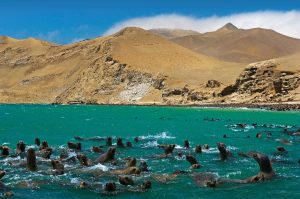Ballestas Islands is a natural wonder full of surprises, is part of the numerous Guano Islands found along the Peruvian coastal line. The island is characterized for being populated by diverse animals and also for being covered in “guano”, the Quechua word for the accumulated excrement of the maritime animals that inhabit there. Also, the island’s guano had an important role during the 19th and 20th centuries as it was the most important fertilizer exported at that time in the world.
Besides, the Humboldt Current, both warm and cold current, in Peru allows ideal conditions for a vast diversity of animals to live and thrive in the Ballestas Islands. Therefore, creating an optimal zone for fish to exist, and consequently attracting predators.
In our Ballestas Islands tour, Travel buddies will take you to watch these amazing animals that live here in their natural habitat. And, of course, while respecting and complying with the local protection regulations.
Here you can find a list of the animals you might see:
Table of Contents
1. Humboldt Penguin

Did you know penguins also live in warm climates? The Humboldt Penguins are medium-sized penguins that live in warm climates along the Pacific Coast of South America. They’re a migrant species that mostly feed on anchovies and crustaceans. Despite they’re an endangered species you can still find them on Ballestas Islands!
2. Peruvian Pelican

The Peruvian Pelican is one of the numerous bird species you will see at these islands. They’re often seen on rocks or piers searching for carrion in fishing ports. They’re characterized for their orange yellow peaks and a blue “bag” underneath their peak where they store the fish they catch.
3. Humpback Whales

Their presence is definitely more scarce but if you visit the islands during their mating season, between August and October, you might have the chance to spot them! They migrate north up to 25,000 km a year during their breeding season. And as expected, they’re large, having a size between 13 and 16 meters.
4. Guanay Cormorant

As you might’ve guessed, their name comes from the fertilizer “guano” , as they’re the main birds that produce this fertilizer. Their breeding occurs year-round with a peak in November and December. Additionally, their nests are built on guano flat surfaces on remote headlands or offshore islands like the Ballestas.
5. Sea Lion (South American)

These adorable mammals are easily spotted lying lazily over the rocky surfaces found on the Ballestas. The sea lions live in colonies of 15 so expect to find a lot of them during the tour. Their presence in the Peruvian coast dates back to the Moche pre-Columbian civilization, where they were considered deities of the sea.
YoYou can discover all these fantastic animals with us in our experiences:





